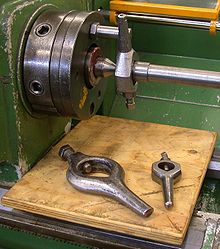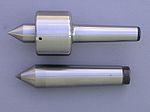- Lathe center
-
A lathe center, often shortened to center, is a tool that has been ground to a point as to accurately position a workpiece about an axis. They usually have an included angle of 60°, but in heavy machining situations an angle of 75° is used.[1]
The primary use of a center is to ensure concentric work is produced, this allows the workpiece to be transferred between operations without any loss of accuracy. A part may be turned in a lathe, sent off for hardening and tempering and then ground between centers in a cylindrical grinder. The preservation of concentricity between the turning and grinding operations is crucial for quality work.
A center is also used to support longer workpieces where the cutting forces would deflect the work excessively, reducing the finish and accuracy of the workpiece, or creating a hazardous situation.
A center has applications anywhere that a centered workpiece may be used, this is not limited to lathe usage but may include setups in dividing heads, cylindrical grinders, tool and cutter grinders or other related equipment. The term between centers refers to any machining operation where the job needs to be performed using centers.
A center is inserted into a matching hole drilled by a center drill.
Contents
Dead center
A dead center (one that does not turn freely, i.e., dead) may be used to support the workpiece at either the fixed or rotating end of the machine. When used in the fixed position, a dead center produces friction between the workpiece and center, due to the rotation of the workpiece. Lubrication is therefore required between the center and workpiece to prevent friction welding from occurring. Additionally the tip of the center may have an insert of carbide which will reduce the friction slightly and allow for faster speeds. Dead centers may also be fully hardened to prevent damage to the important mating surfaces taper of the taper and to preserve the 60° nose taper.
Soft center
Soft centers are identical to dead centers except the nose is deliberately left soft (unhardened) so that it may be readily machined to the correct angle prior to usage. This operation is performed on the headstock center to ensure that the centers axis is aligned with the spindles axis.
Live or revolving center
A live center or revolving center is constructed so that the 60° center runs in its own bearings and is used at the non-driven or tailstock end of a machine.[2] It allows higher turning speeds without the need for separate lubrication, and also greater clamping pressures. CNC lathes use this type of center almost exclusively and they may be used for general machining operations as well. Spring-loaded live centers are designed to compensate for center variations, without damage to the work piece or center tip. This assures the operator of uniform constant tension while machining. Some live centers also have interchangeable shafts. This is valuable when situations require a design other than a 60° male tip.
Pipe center
A pipe center has a larger diameter at the 60° taper end. This allows the center to be used in the bore of a pipe (or similar workpiece). While a pipe center ensures the workpiece remains concentric, its main advatage is that it supports the workpiece securely. Thin walled material such as pipes easily collapse if excessive pressures are used at the chuck end,
Cup center
The cup center is a variation of the live center and is used in woodworking to support the softer material around the actual center and prevent the material splitting.
Drive center
A drive center is used in the driving end of the machine (headstock). It consists of a dead center surrounded by hardened teeth. These teeth bite into the softer workpiece allowing the workpiece to be driven directly by the center. This allows the full diameter of the workpiece to be machined in a single operation, this contrasts with the usual requirement where a carrier is attached to the workpiece at the driven end. They are often used in woodworking or where softer materials are machined.
Drive Centre is also known as Grip centre in some industrial circles. Another modification made to the Drive centre is that Shell End Mills are modified and used instead of hardened pins that enable better gripping and also that used of used Shell end mills after Grinding the edges. This prevents breakdown time due to pin stop
Spring Center
A spring center is a metalworking lathe center for maintaining a cutting tool like a reamer or a tap, in axial alignment with a hole being worked on. It consists of a point backed by a spring to push the cutting tool into the workpeice.
References
- ^ International library of technology: Drilling; Lathe work; Boring-mill work; Working chilled iron; Bench, vise, and floor work; Erecting, 138, International Textbook, 1914, p. 21, http://books.google.com/books?id=_Q9WAAAAMAAJ&dq=%22lathe%20center%22&pg=RA2-PA21.
- ^ Culley, Ron (1988, 1989, 1991, 1994, 1996, 1997). isbn = 0724138196 Fitting and machining. PO Box 12477, Melbourne, Victoria: RMIT Publications. http://rmitpublishing.com.au/ isbn = 0724138196.
Metalworking Machining and computing Computer-aided engineering Drilling and threading Grinding and lapping Abrasive · Angle grinder · Bench grinder · Coated abrasives · Cylindrical grinder · Diamond plate · Flick grinder · Dresser · Grinding · Grinding machine · Grinding wheel · Jig grinder · Lapping · Sanding · Sharpening stone · Spark testing · Surface grinder · Tool and cutter grinderMachining and milling Electrical discharge machining · Electrochemical machining · Endmill · Engraving · Hobbing · Lathe · Machine tool · Machining · Milling cutter · Milling machine · Planer · Pantograph · ShaperMachine tooling Angle plate · Chuck · Collet · Jig · Fixture · Indexing head · Lathe center · Machine taper · Magnetic base · Mandrel · Rotary table · WigglerTerminology Casting · Fabrication · Forming · Jewellery · Machining · Metallurgy · Smithing · Tools and terminology · WeldingCategories:- Woodworking
- Lathes
Wikimedia Foundation. 2010.


